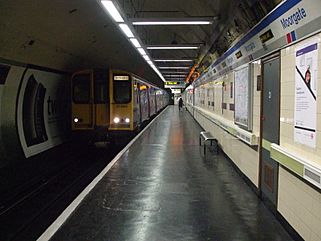Northern City Line facts for kids
Quick facts for kids Northern City Line |
|
|---|---|

|
|
| Overview | |
| Status | Operational |
| Owner | Network Rail |
| Locale | Greater London |
| Termini | Finsbury Park London Moorgate |
| Stations | 6 |
| Service | |
| Type | Commuter rail, Suburban rail |
| System | National Rail |
| Operator(s) | Great Northern |
| Depot(s) | Hornsey |
| Rolling stock | Class 313 Class 717 |
| History | |
| Opened | 1904 |
| Technical | |
| Number of tracks | Two |
| Track gauge | 1,435 mm (4 ft 8 1⁄2 in) standard gauge |
| Loading gauge | W6 |
| Electrification | 25 kV 50 Hz AC OHLE (Drayton Park and north) 750 V DC third rail (Drayton Park and south) |
The Northern City Line is a special railway line in London, England. It's like a busy highway for trains that carries people who travel to work or school every day. The line runs from London Moorgate to Finsbury Park. But trains don't just stop there; they continue on to other places!
This line is part of the Great Northern Route and acts as a branch of the important East Coast Main Line. The Northern City Line goes underground from Moorgate to Drayton Park. After that, it runs in a deep trench, called a cutting, until it joins the main East Coast Line near Finsbury Park. This railway connects different parts of northern London all the way to the City of London, which is a big financial area. Since 2015, more trains run on this line, even late in the evenings and on weekends, making it easier for people to travel.
Contents
What is the Northern City Line?
The official name for this railway is actually the Moorgate Line. However, most people don't call it that. This is because there's another railway line with a similar name. It used to be part of the London Underground network, which is London's famous subway system. Even though it was managed by London Transport, it was never directly connected to the Metropolitan or Northern Underground lines.
A Look at Its History
The Northern City Line was built a long time ago, in 1904. It was originally a separate route that ended at Finsbury Park. It was one of London's "deep-level" railways, meaning it ran far below the ground.
In 1976, the line was changed and connected to the wider British Rail network. This is when it started running the way it does today. Now, the Northern City Line is owned by Network Rail, which manages most of the railway tracks in Britain. The trains on this line are operated by Great Northern. They run from Moorgate to Finsbury Park and then continue into Hertfordshire, a county just north of London.
Future Plans for the Line
In 2016, there was a suggestion to transfer all London train services, including the Northern City Line, to Transport for London (TfL). TfL is the company that runs London's buses and the Underground. The idea was to create a "London Suburban Metro" system. If this happened, the Northern City Line would once again be managed by TfL, bringing it back under their control after many years.
Images for kids
-
The planned 1930s Northern Heights extensions, showing the diversion of the Northern City Line to Alexandra Palace, Bushey Heath and High Barnet. Sections marked in solid green were ultimately taken over. The line from Highgate to Finsbury Park already existed but was to be absorbed by London Transport; this never happened and it closed to passengers in 1954. After being used to transfer tube trains from Highgate depot to the Northern City line, it closed permanently in 1970.




